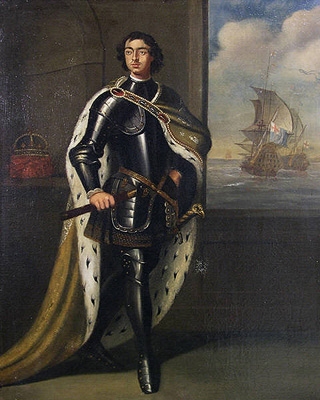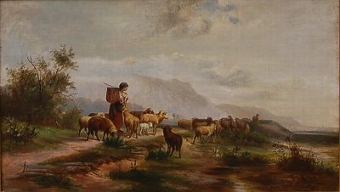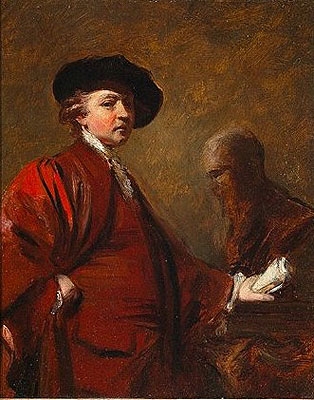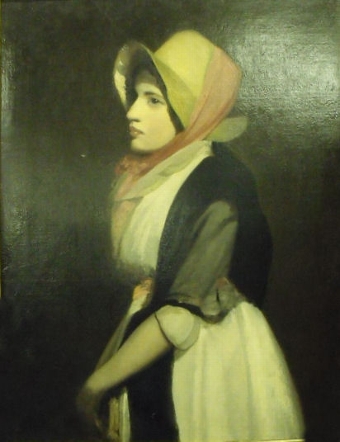This painting is one of many inspired by the original portrait, found in The Royal Collection, and painted in 1698 by British artist Sir Godfrey Kneller at the time of Peter the Great''s visit to England.
Czar Peter the Great visited London from 10/11th January 1698- 21st April 1698. Various portraits and preparatory drawings resulted from this visit. Of which the largets portrait now in the Royal collection at Hampton court meausuring 91 x 55in. This portrait was commissioned by William III for which preparatory sketches were done in Utrecht in 1697. Peter the Great ruled the Russian Empire from 7 May [O.S. 27 April] 1682 until his death, jointly ruling before 1696 with his weak and sickly half-brother, Ivan V. Peter carried out a policy of Westernization and expansion that transformed the Tsardom of Russia into the Russian Empire, a major European power.
Peter was born in 1672 in Moscow to Alexis I of Russia and his second wife Nataliya Kyrillovna Naryshkina, within the walls of the Kremlin.Young Peter with imperial regalia.Alexis I, the then-current Tsar died on January 29, 1676 and Peter''s half-brother, Feodor III became tsar. He died six years later in 1682. As Feodor did not leave any children, a dispute arose between the Naryshkin and Miloslavsky families over who should inherit the throne. Peter''s other half-brother, Ivan V, was the next for the throne, but he was chronically ill and of infirm mind. Consequently, the Boyar Duma (a council of Russian nobles) chose the ten-year old Peter to become Czar, his mother becoming regent. But one of Alexei''s daughters by his first marriage, Sophia Alekseyevna, led a rebellion of the Streltsy (Russia''s ?lite military corps). In the subsequent conflict, some of Peter''s relatives and friends were murdered, and Peter witnessed some of these acts of political violence.
The Streltsy uprising of April-May 1682 made it possible for Sophia, the Miloslavskys (the clan of Ivan), and their allies, to insist that Peter and Ivan be proclaimed joint Tsars, with Ivan being acclaimed as the senior of the two. Sophia acted as regent during the minority of the two sovereigns and exercised all power. Peculiarly, a large hole was cut in the back of the dual-seated throne used by Ivan and Peter. Sophia would sit behind the throne and listen as Peter conversed with nobles, also feeding him information and giving him responses to questions and problems. This throne can be seen in the Kremlin museum in Moscow. For seven years, she ruled as an autocrat.Peter was not particularly concerned that others ruled in his own name. He engaged in such pastimes as shipbuilding and sailing, as well as mock battles with his toy army. Peter''s mother sought to force him to adopt a more conventional approach and arranged his marriage to Eudoxia Lopukhina in 1689. The marriage was a failure, and ten years later Peter forced her to become a nun and thus freed himself from the union.
By the summer of 1689, Peter planned to take power from his half-sister Sophia, whose position had been weakened by two unsuccessful Crimean campaigns. When she learned of his designs, Sophia began to conspire with the leaders of the streltsy, who continually aroused disorder and dissent of the tsar''s rule. Unfortunately for Sophia, Peter, warned by the Streltsy, escaped in the middle of the night to the impenetrable monastery of Troitsky; there he slowly gathered his adherents and others, who perceived he would win the power struggle. She was therefore overthrown, with Peter I and Ivan V continuing to act as co-tsars. Peter forced Sophia to enter a convent, where she gave up her name and position as a member of the royal family.Still, Peter could not acquire actual control over Russian affairs. Power was instead exercised by his mother, Nataliya Naryshkina. It was only when Nataliya died in 1694 that Peter became an independent sovereign.[4] Formally, Ivan V remained a co-ruler with Peter, although he was still ineffective. Peter became the sole ruler when Ivan died in 1696.
Peter the First Looking at the Baltic Sea.Peter grew to be quite tall as an adult, especially for the time period. Standing at nearly seven feet in height, the Russian tsar was literally head and shoulders above his contemporaries both in Russia and throughout Europe.Peter, however, lacked the overall proportional heft and bulk generally found in a man that size. Both Peter''s hands and feet were small, and his shoulders narrow for his height; likewise, his head was also small for his tall body. Added to this were Peter''s noticeable facial tics, and, judging by descriptions handed down, he may have suffered from petit mal, a form of epilepsy.
Filippo Baltari, a young Italian visitor to Peter''s court, wrote:"Tsar Peter was tall and thin, rather than stout. His hair was thick, short, and dark brown; he had large eyes, black with long lashes, a well-shaped mouth, but the lower lip was slightly disfigured...For his great height, his feet seemed very narrow. His head was sometimes tugged to the right by convulsions."Otherwise, judging by documents?or lack thereof?that have managed to survive to the present day, few contemporaries, either in or outside of Russia, commented on Peter''s great height or appearance.
Peter implemented sweeping reforms aimed at modernizing Russia. Heavily influenced by his western advisors, Peter reorganized the Russian army along European lines and dreamed of making Russia a maritime power. He faced much opposition to these policies at home, but brutally suppressed any and all rebellions against his authority, the rebelling of streltsy, Bashkirs, Astrakhan and including the greatest civil uprising of his reign, the Bulavin Rebellion. Further, Peter implemented social westernization in an absolute manner by requiring courtiers, state officials, and the military to shave their beards and adopt Western clothing styles.To improve his nation''s position on the seas, Peter sought to gain more maritime outlets. His only outlet at the time was the White Sea at Arkhangelsk. The Baltic Sea was at the time controlled by Sweden in the north, while the Black Sea was controlled by the Ottoman Empire in the south. Peter attempted to acquire control of the Black Sea, but to do so he would have to expel the Tatars from the surrounding areas. He was forced, as part of an agreement with Poland, which ceded Kiev to Russia, to wage war against the Crimean Khan and against the Khan''s overlord, the Ottoman Sultan. Peter''s primary objective became the capture of the Ottoman fortress of Azov, near the Don River. In the summer of 1695 Peter organized the Azov campaigns in order to take the fortress, but his attempts ended in failure. Peter returned to Moscow in November of that year, and promptly began building a large navy. He launched about thirty ships against the Ottomans in 1696, capturing Azov in July of that year. On September 12, 1698, Peter The Great officially founded the first Russian Navy base, Taganrog.
The Peter the Great statue in Taganrog by Mark AntokolskiPeter knew that Russia could not face the Ottoman Empire alone. In 1697, he traveled incognito to Europe on an 18-month journey with a large Russian delegation?the so-called "Grand Embassy"?to seek the aid of the European monarchs.[8] Peter''s hopes were dashed; France was a traditional ally of the Ottoman Sultan, and Austria was eager to maintain peace in the east whilst conducting its own wars in the west. Peter, furthermore, had chosen the most inopportune moment; the Europeans at the time were more concerned about who would succeed the childless Spanish King Charles II than about fighting the Ottoman Sultan.
The "Great Embassy", although failing to complete the mission of creating an anti-Ottoman alliance, still continued to travel across Europe. In visiting Holland, Peter learned much about Western culture. He studied shipbuilding in Zaandam and Amsterdam. Thanks to the mediation of Nicolaas Witsen, mayor of Amsterdam and expert on Russia par excellence, the czar was given the opportunity to gain practical experience in the largest shipyard in the world, belonging to the Dutch East India Company, for a period of four months. The Tsar helped with the construction of an East Indiaman especially laid down for him: Peter and Paul. During his stay the tsar engaged many skilled workers such as builders of locks, fortresses, shipwrights and seamen. Cornelis Cruys, a vice-admiral who became under Franz Lefort the Tsar''s advisor in maritime affairs. Besides Peter paid a visit to Frederik Ruysch, who taught him how to draw teeth and catch butterflies. Also Ludolf Bakhuysen, a painter of seascapes and Jan van der Heyden the inventor of the fire hose, received Peter, who was keen on learning and bringing home what he had seen. On January 16, 1698 Peter organized his farewell party and invited Johan Huydecoper van Maarsseveen, who had to sit between Lefort and the tsar and drink.
A statue of Peter I on the bank of the Moskva River is one of the tallest outdoor sculptures in the world.[9]In England he met with King William III, visited Greenwich, Oxford, was painted by sir Godfrey Kneller and saw a Fleet Review, Royal Navy in Deptford. He also travelled to the fledgling city of Manchester to learn the techniques of city building he would later use to great effect at Saint Petersburg. Then the Embassy went to Leipzig, Dresden and Vienna. He spoke with August the Strong and Leopold I, Holy Roman Emperor. The Embassy did not make it to Venice. The visit of Peter was cut short in 1698, when he was forced to rush home by a rebellion of the streltsy. The rebellion was, however, easily crushed before Peter returned home from England; of the Tsar''s troops, only one was killed. Peter nevertheless acted ruthlessly towards the mutineers. Over 1200 of the rebels were tortured and executed, and Peter ordered that their bodies be publicly exhibited as a warning to future conspirators. The streltsy were disbanded, and the individual they sought to put on the Throne?Peter''s half-sister Sophia?was forced to become a nun.
Also, upon his return from his European tour, Peter sought to end his unhappy marriage. He divorced the Tsaritsa, Eudoxia Lopukhina. The Tsaritsa had borne Peter three children, although only one?the Tsarevich Alexei?had survived past his childhood.In 1698, Peter sent a delegation to Malta under boyar Boris Petrovich Sheremetyev, to observe the training and abilities of the Knights of Malta and their fleet. Sheremetyev also investigated the possibility of future joint ventures with the Knights, including action against the Turks and the possibility of a future Russian naval base. Peter''s visits to the West impressed upon him the notion that European customs were in several respects superior to Russian traditions. He commanded all of his courtiers and officials to cut off their long beards?causing his Boyars, who were very fond of their beards, great upset?and wear European clothing. Boyars who sought to retain their beards were required to pay an annual beard tax of one hundred rubles. He also sought to end arranged marriages, which were the norm among the Russian nobility, because he thought such a practice was not only barbaric but also led to domestic violence since the partners usually resented each other in this forced union.In 1699, Peter also changed the celebration of new year from 1st September to 1 January. Traditionally, the years were reckoned from the purported creation of the World, but after Peter''s reforms, they were to be counted from the birth of Christ.
Peter made a temporary peace with the Ottoman Empire that allowed him to keep the captured fort of Azov, and turned his attention to Russian maritime supremacy. He sought to acquire control of the Baltic Sea, which had been taken by Sweden a half-century earlier. Peter declared war on Sweden, which was at the time led by King Charles XII. Sweden was also opposed by Denmark-Norway, Saxony, and the Polish-Lithuanian Commonwealth.Peter I of Russia pacifies his marauding troops after taking Narva in 1704 by Nikolay Sauerweid, 1859Russia turned out to be ill-prepared to fight the Swedes, and their first attempt at seizing the Baltic coast ended in disaster at the Battle of Narva in 1700. In the conflict, the forces of Charles XII used a blinding snowstorm to their advantage. After the battle, Charles XII decided to concentrate his forces against the Polish-Lithuanian Commonwealth, giving Peter I time to reorganize the Russian army.
As the Poles and Lithuanians on one side and Swedes on the other fought each other, Peter founded the city of Saint Petersburg (Germanically named after Saint Peter the Apostle) in Izhora (which he had re-captured from Sweden) in 1703. He forbade the building of stone edifices outside Saint Petersburg ? which he intended to become Russia''s capital ? so that all the stonemasons could participate in the construction of the new city. He also took Martha Skavronskaya as a mistress. Martha converted to the Russian Orthodox Church and took the name Catherine, allegedly marrying Peter in secret in 1707. In any case Peter valued Catherine and proceeded to marry her again (this time officially) at Saint Isaac''s Cathedral in Saint Petersburg on 9 February 1712.Following several defeats, the Polish King August II abdicated in 1706. Charles XII turned his attention to Russia, invading it in 1708. After crossing into Russia, Charles defeated Peter at Golovchin in July. In the Battle of Lesnaya, however, Charles suffered his first loss after Peter crushed a group of Swedish reinforcements marching from Riga. Deprived of this aid, Charles was forced to abandon his proposed march on Moscow.Peter I in the Battle of Poltava (a mosaic by Mikhail Lomonosov)Charles XII refused to retreat to Poland or back to Sweden, instead invading Ukraine. Peter withdrew his army southward, destroying any property that could assist the Swedes along the way. Deprived of local supplies, the Swedish army was forced to halt its advance in the winter of 1708?1709. In the summer of 1709, they nevertheless resumed their efforts to capture Ukraine, culminating in the Battle of Poltava on 27 June. The battle was a decisive defeat for Swedish forces, ending Charles'' campaign in Ukraine and forcing him into exile in the Ottoman Empire. In Poland, August II was restored as King.
Peter, overestimating the support he would receive from Balkan allies, attacked the Ottoman Empire in 1711.[14] Normally, the Boyar Duma would have exercised power during his absence. Peter, however, mistrusted the boyars; he instead abolished the Duma and created a Senate of ten members. Peter''s campaign in the Ottoman Empire was disastrous, and in the ensuing peace treaty, Peter was forced to return the Black Sea ports he had seized in 1697. In return, the Sultan expelled Charles XII, but Russia was forced to guarantee safe passage to the Swedish king.Peter''s northern armies took the Swedish province of Livonia (the northern half of modern Latvia, and the southern half of modern Estonia), driving the Swedes back into Finland. In 1714 the Russian fleet won the Battle of Gangut. Most of Finland was occupied by the Russians. In 1716 and 1717, the Tsar revisited the Netherlands, and went to see Herman Boerhaave. He continued his travel to the Austrian Netherlands and France. The Tsar''s navy was so powerful that the Russians could penetrate Sweden. Peter also obtained the assistance of the Electorate of Hanover and the Kingdom of Prussia. Still, Charles XII refused to yield, and not until his death in battle in 1718 did peace become feasible. After the battle near ?land Sweden made peace with all powers but Russia by 1720. In 1721, the Treaty of Nystad ended what became known as the Great Northern War. Russia acquired Ingria, Estonia, Livonia and a substantial portion of Karelia. In turn, Russia paid two million Riksdaler and surrendered most of Finland. The Tsar was, however, permitted to retain some Finnish lands close to Saint Petersburg, which he had made his capital in 1712. He gained access to a warm-water-port during his reign for easier trading with the Western world.
Diamond order of Peter the Great.Peter I''s last years were marked by further reform in Russia. On 22 October 1721, soon after peace was made with Sweden, he was acclaimed Emperor of All Russia. Some proposed that he take the title Emperor of the East, but he refused. Gavrila Golovkin, the State Chancellor, was the first to add "the Great, Father of His Country, Emperor of All the Russias" to Peter''s traditional title Tsar following a speech by the archbishop of Pskov in 1721.Peter''s imperial title was recognized by Augustus II of Poland, Frederick William I of Prussia and Frederick I of Sweden, but not by the other European monarchs. In the minds of many, the word emperor connoted superiority or pre-eminence over "mere" kings. Several rulers feared that Peter would claim authority over them, just as the Holy Roman Emperor had once claimed suzerainty over all Christian nations.
Peter also reformed the government of the Russian Orthodox Church. The traditional leader of the Church was the Patriarch of Moscow. In 1700, when the office fell vacant, Peter had refused to name a replacement, allowing the Patriarch''s Coadjutor (or deputy) to discharge the duties of the office. Twenty-one years later, in 1721, Peter followed the advice of Feofan Prokopovich and erected the Holy Synod, a council of ten clergymen, to take the place of the Patriarch and Coadjutor. Peter also implemented a law which stipulated that no Russian man could join a monastery before the age of 50. He felt that too many able Russian men were being wasted away by clerical work when they could be joining his new and improved army. And in 18th century Russia, few people (men and women) lived to over a half century, therefore very few men became monks during Peter''s reign, much to the dismay of the Russian Church.
In 1722, Peter created a new order of precedence, known as the Table of Ranks. Formerly, precedence had been determined by birth. In order to deprive the Boyars of their high positions, Peter directed that precedence should be determined by merit and service to the Emperor. The Table of Ranks continued to remain in effect until the Russian monarchy was overthrown in 1917. In addition, Peter decided that all of the children of the nobility should have some early education, especially in the areas of sciences. Therefore, on February 28, 1714, he introduced the decree on compulsory education which dictated that all Russian children of the nobility, of government clerks and even lesser ranked officials between the ages of 10 and 15 must learn basic mathematics and geometry and that they should be tested on it at the end of their studies.Peter also introduced new taxes to fund improvements in Saint Petersburg. He abolished the land tax and household tax, and replaced them with a capitation. The taxes on land on households were payable only by individuals who owned property or maintained families; the new head taxes, however, were payable by serfs and paupers.
In 1724, Peter had his second wife, Catherine, crowned as Empress, although he remained Russia''s actual ruler. All of Peter''s male children had died?the eldest son, Alexei, had been tortured and killed on Peter''s orders in 1718 because he had disobeyed his father and opposed official policies. At the same time, Alexei''s mother Eudoxia had also been punished; she was dragged from her home and tried on false charges of adultery. A similar fate befell Peter''s beautiful mistress, Anna Mons, in 1704.In 1725, construction of Peterhof, a palace near Saint Petersburg, was completed. Peterhof (Dutch for "Peter''s Court") was a grand residence, becoming known as the "Russian Versailles".
In the winter of 1723, Peter, whose overall health was never robust, began having problems with his urinary tract and bladder. In the summer of 1724 a team of doctors performed the necessary surgery releasing upwards of four pounds of blocked urine. Peter remained bedridden till late autumn. Then in the first week of October, restless and certain he was cured, Peter began a lengthy inspection tour of various projects. According to legend, it was in November, while at Lakhta along the Finnish Gulf to inspect some ironworks, that Peter saw a group of soldiers drowning not far from shore and, wading out into near-waist deep water, came to their rescue.
Peter the Great on his deathbed.This icy water rescue is said to have exacerbated Peter''s bladder problems and caused his death on February 8, 1725. The story, however, has been viewed with skepticism by some historians, pointing out that the German chronicler Jacob von St?hlin is the only source for the story, and it seems unlikely that no one else would have documented such an act of heroism. This, plus the interval of time between these actions and Peter''s death seems to preclude any direct link. However, the story may still, in part, contain some grain of truth.
In early January 1725, Peter was struck once again with uremia. Legend has it that before lapsing into unconsciousness Peter asked for a paper and pen and scrawled an unfinished note that read: "Leave all to...." and then, exhausted by the effort, asked for his daughter Anna to be summoned.
Peter died between four and five in the morning February 8, 1725. An autopsy revealed his bladder to be infected with gangrene. He was fifty-two years, seven months old when he died, having reigned forty-two years.The most famous (1782) statue of Peter I in Saint Petersburg, informally known as the Bronze Horseman. The tomb of Peter the Great in Peter and Paul Fortress.Peter inherited an uneducated, untrained, uncivilized and superstitious country that excluded itself from European society, economy, and politics. In large measure, Peter exchanged tradition in favor of modernization. Peter the Great prodded a relatively backwards Muscovy state into a modernized Russia that competed with other European powers.
Antiques.co.uk Ref: VNFFBFBA
- Materials:
- Oil on Canvas
- Width (cm):
- 88.90 x 76.20 (cm) (35 x 30 ins.)














